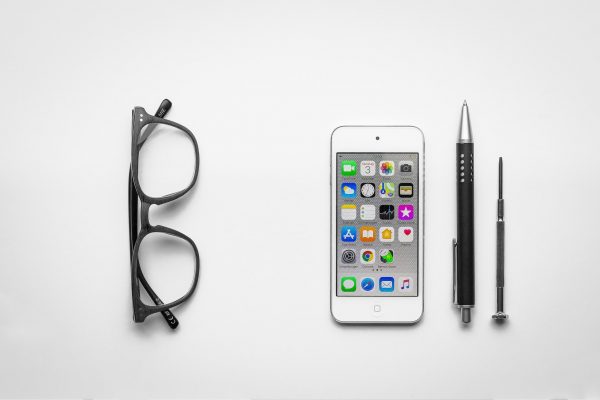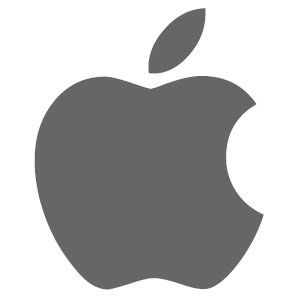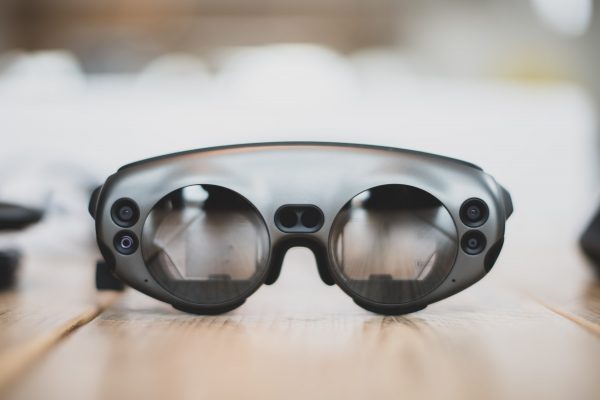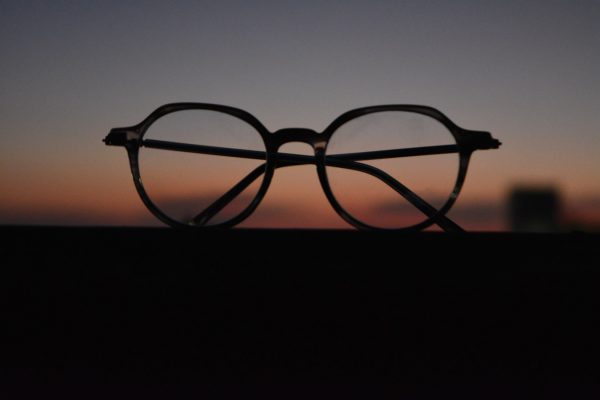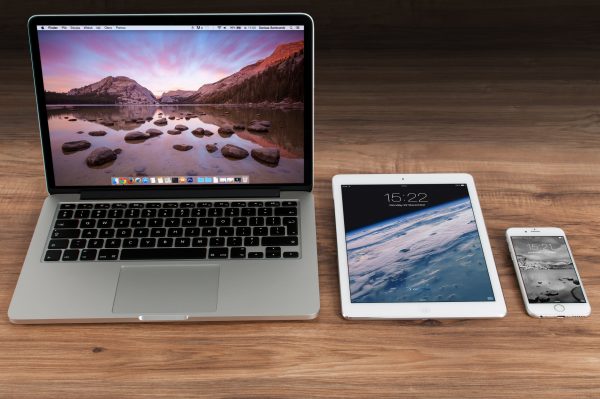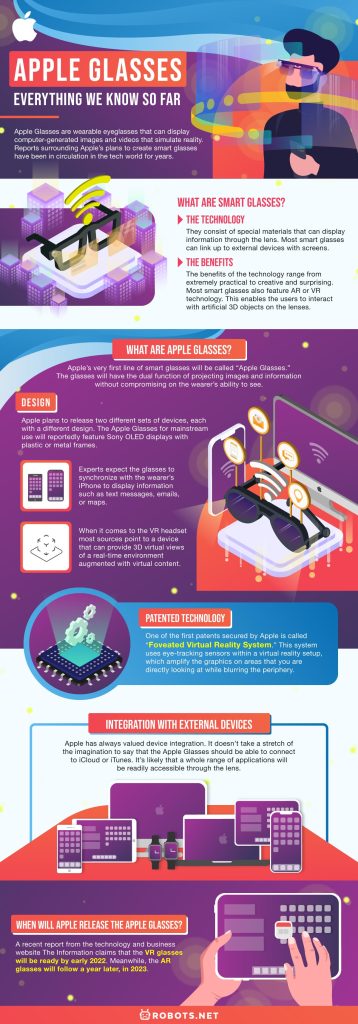Reports have confirmed that Apple plans to release two sets of wearable devices: a pair of smart glasses with VR technology and a headset combining AR/VR technology. There’s nothing final yet about specifications, but many trusted Apple sources have started to spill the beans about what’s in the works. Let’s dive in on crucial details about the next big release from the tech giant.
What Are Smart Glasses?
The Technology
The Benefits
What Are Apple Glasses?
What Do We Know So Far About Apple Glasses?
Smart glasses typically look like your standard pair of glasses. But in truth, they consist of special materials that can display information through the lens. Most smart glasses can link up to external devices with screens. The purpose is to get information and to offload processing power. This linkage is how it gets applications, texts, emails, internet searches, videos, and other information to reflect straight onto the glass lenses. Most smart glasses also contain a small microphone and wireless audio input. This enables the user to play music and take calls wirelessly. They may also contain a camera that can take pictures or analyze real-time footage to identify objects therein. The controls for smart glasses vary according to make and model. But as far as we know, manufacturers make use of three methods to control them. The first type of control is via hand gestures. The smart glasses using this method have motion sensors embedded in the frames. Some models have built-in microphones and digital assistants like Siri or Google Assistant. The digital assistants are able to communicate and take on voice commands. Other models rely on a dedicated app that will serve as the remote control for the device. Most smart glasses also feature AR or VR technology. This enables the users to interact with artificial three-dimensional objects on the lenses. For example, you can keep a virtual pet that only you can see and have it run around your home. You can also watch a movie straight from the glasses without the need for a television. Besides the AR and VR functions, smart glasses can also project text culled from internet searches or files on your phone. This allows for hands-free reading while driving or walking. Other types of smart glasses have built-in cameras and microphones. You can use these to take photographs or video footage anywhere, anytime. Other devices have facial recognition technology. You can use this to identify friends and family from a distance. Smart glasses are a relatively new technology. As such, there are significant controversies as to their real benefits. But somewhere down the road, scientists and engineers hope that AR and VR will be the next computing platform to replace computer screens and televisions. As such, it might be best to suspend our judgment about the technology’s potential use cases until the technology develops further. Apple plans to release two pairs of glasses. One will be augmented reality (AR) smart glasses and the other a headset combining AR and virtual reality (VR). We can refer to them in shorthand as AR glasses and VR headsets. The AR glasses will be a pair of lightweight and normal-looking pair of smart glasses. On the other hand, the VR headsets will be a heavier device that can accommodate both VR and AR games. The former is clearly intended for more casual buyers, while the latter is for more niche groups. If you want to delve deeper into the differences between these two, check out this article about augmented reality vs. virtual reality.
Design
Patented Technology
Experts expect the glasses to synchronize with the wearer’s iPhone to display information such as text messages, emails, or maps. The controls for everything will be placed on a dedicated app on the smartphone. Most iOS apps should also work on the glasses. The glasses are also compatible with AR games. These are games that superimpose digital characters or settings onto their actual environment. When it comes to the VR headset, most sources point to a device that can provide 3D virtual views of a real-time environment augmented with virtual content. The device will reportedly take on a slimmer, fabric-swathed version of the Oculus Quest in terms of appearance. But unlike the Oculus, this particular headset will make use of more vibrant displays, 8K quality to be exact, for both left and right displays. The headset will also use patented digital light processing sensors that can track for changes in lighting conditions. It will also have motion sensors that can track movement, location, and even facial expressions. It’s also been reported that one of the best virtual assistants, Siri, will grace the headset. However, Apple appears to be testing a separate device that can act as a remote control for the headset, which seems practical for a device as heavy as this. Apple has acquired a long list of patents to support their AR/VR research, but there are a few of them worth mentioning. One of the first patents secured by Apple is called “Foveated Virtual Reality System.” This system uses eye-tracking sensors within a virtual reality setup, which amplify the graphics on areas that you are directly looking at while blurring the periphery. It creates a kind of tunnel vision that allows you to see clearly without compromising on speed. The feature will save the headset’s battery power, which would most likely rely on rechargeable batteries. This patent seems to support the long-held idea of split rendering. Split rendering essentially offloads most AR and VR processing to an external device. This preserves the battery life of the headset while leaving the hard work to the smartphone. Apple acquired another AR/VR patent back in 2016. This patent describes a headset that can be “coupled” with an Apple smartphone to view the phone screen images. The proposed HMD would also contain built-in headphones, a lighting connector to merge the two devices, an eyeglass-like form factor, and custom lenses. The key factor has to do with the close integration of the headset with the iPhone. Apple also recently acquired a patent entitled “Display System With Localized Optical Adjustments.” This patent points to an adjustable lens system that adapts to varying lighting conditions. Apple also acquired a patent for Chroma keying. This can replace solid color backgrounds with a digital overlay. Patents such as this point not only to feature-packed devices but also to devices with clearly defined benefits.
Integration With External Devices
Apple has always valued device integration. Devices like the AirPods and Apple Watch can pair for audio with the watch serving as the remote control. Most of the devices like the Apple TV, the iPad, the iPhone, or the Mac can also pass information in one form or another. It’s a whirlwind of connected devices that can interact with each other and pass on data. This interconnectedness is made possible for the most part with the help of applications like iCloud, which automatically syncs files between devices. It doesn’t take a stretch of the imagination to say that the Apple Glasses should be able to connect to iCloud or iTunes. It’s likely that a whole range of applications will be readily accessible through the lens. Likely additions to the list would include the company’s gaming subscription service, Apple Arcade, or the cashless payment service, Apple Pay. Information culled from patent documents indicate that the smart glasses will unlock other Apple devices around it without requiring a password. Suppose you’re familiar with the Apple system. In that case, all that’s required to control and manage multiple Apple devices is a single Apple ID account. This new patent appears to offer a new way to pair devices automatically without the log-in information. And it’s not exactly a novel concept since the feature is already being used in Apple Watch and Mac. If the user is wearing an active watch next to a Mac, the watch can automatically unlock the Mac without a password. The patent also doesn’t say whether the glasses will be the control point for the devices. But it’s most likely going to be the latter.
Benefits of Apple Glasses
When Will Apple Release the Apple Glasses?
Although we’re not sure if the lens will adjust by themselves or if there will be a need to add prescription lenses. The same lenses can adapt to varying lighting conditions, such as under direct sunlight or in the dark. The AR lenses will allow users to experience AR games like Pokemon Go in the most visually stunning and realistic way possible. On the other hand, the VR headset is meant to give niche customers the best possible experience with AR and VR games. The Apple VR headset will feature the best screens and speakers that Apple can provide. These are intended to provide you with an ultra-realistic AR/VR experience. Although Apple is still testing the ideal fit, the headset will appear to have a standard shape to fit most head shapes. The VR headset will also reportedly have its own app store. This should allow for easy access to gaming, audio streaming, and other communications software. And because the device leverages the most advanced chips and displays, it’s most likely going to cost more than the average price for commercial VR headsets. But Apple’s stellar reputation alone assures many consumers that the device’s quality will be worth the investment. There is plenty of speculation about when Apple will finally release the fruits of their labor, but nothing is definitive about them. In 2019, Apple’s AR/VR roadmap suggested that Apple would release their smart glasses by 2020. But despite these speculations, the year passed without any sign of the highly anticipated smart glasses. A recent report from the technology and business website The Information claims that the VR glasses will be ready by early 2022. Meanwhile, the AR glasses will follow a year later, in 2023. According to the report, part of the delay has to do with travel restrictions imposed because of the pandemic. Remote work arrangements are forcing Apple Engineers to spend less time in the highly secretive Apple laboratories. And as it turns out, this type of work setup can have detrimental effects on their planned production schedules. Tech experts familiar with Apple’s marketing protocols have also noted that Apple usually announces their products’ release several months before they are ready to ship. They also considered the fact that most developers would need a head start for making apps that fit the specifications of the device. And this is going to require Apple to share hardware and software information and design guidelines. Since smart glasses are not exactly the usual charade, we can imagine that the developers would need a longer head start. But so far, Apple has declined to comment on any reporting, which has led some to believe that perhaps they haven’t gone past the testing phase yet. The wait can feel frustrating due to the constant postponement of release dates. Nevertheless, Apple will get there and it shall mark the company’s first venture into AR/VR territory.
